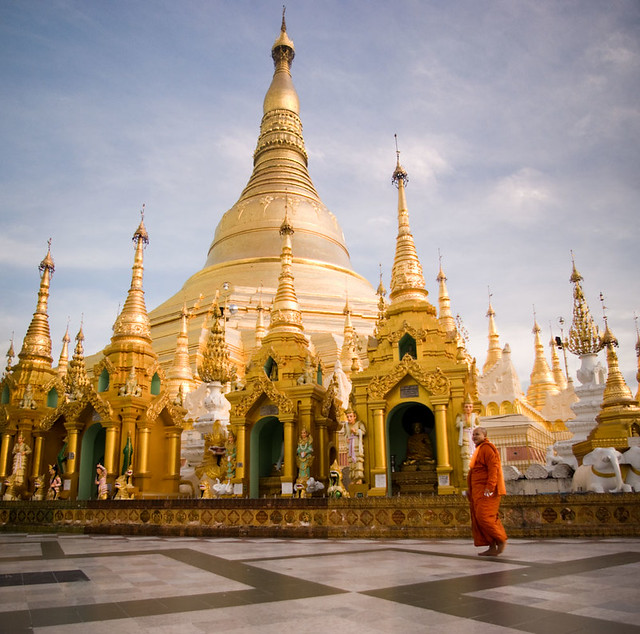
The Shwedagon Pagoda
Yangon, Myanmar. I don't think this is a local monk from Myanmar, but one on holiday as he is wearing different coloured robes.
he Shwedagon Pagoda or Paya is the single most important religious site in all of Myanmar. The pagoda stands on the top of Singuttara Hill, and, according to legend, that spot has been sacred since the beginning of time, just before our present world was created. At that time, five lotus buds popped up on the hill, each bud signifying the five Buddhas who would appear in the world and guide it to Nirvana. Gautama, the Buddha as we know him, is the fourth of these five (Maitreya, the fifth, will announce the end of the world with his appearance) and, according to the legend, two brothers brought eight hairs of the Buddha to be enshrined in this sacred location, inaugurating the Shwedagon Pagoda. Whatever the truth of the legend, verifiable history records a pagoda at the site since the 6th Century AD. Built and rebuilt, guilded and reguilded, almost nothing in the pagoda is likely to be old, except whatever is hidden deep inside the stupa. An earthquake (18th century) destroyed the upper half of the pagoda spire and many buildings. The British used the platform and the temples to house their soldiers and armory and, allegedly, made off with anything of value. And Burmese Buddhists are inherently practical people who constantly build and rebuild pagodas for merit.
Today, the pagoda is a magical place that most visitors to Yangon come again and again. Unlike other religious sites, it has at once a spiritual as well as a secular feel about it. Children run up and down singing songs, monks sit on the steps chatting, young men cast amorous glances at women, women stand around gossiping, all while others are deep in prayer in front of whatever shrine has significance for them. A sort of religious version of Times Square, the Shwedagon captures the essence of both the informal nature as well as the strong ties that signify the relationship that the Burmese have with their Buddhism. There is no other pagoda like it in Burma and there is no other place like the Shwedagon Pagoda in the world and visitors to Burma end up spending a lot of their time there.
wikitravel.org/en/Yangon#See
Tags
Asia
Burma
Myanmar
Travel
No comments:
Post a Comment